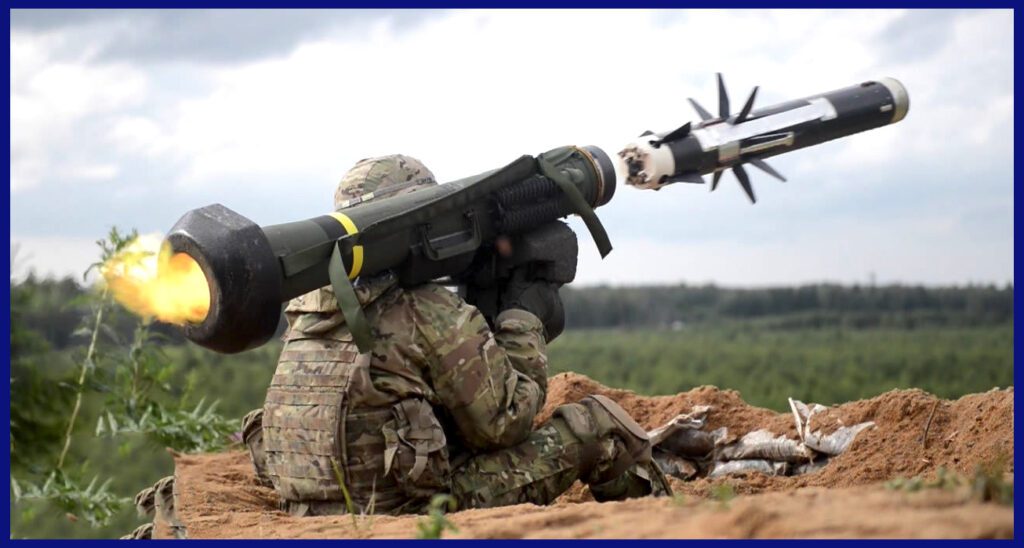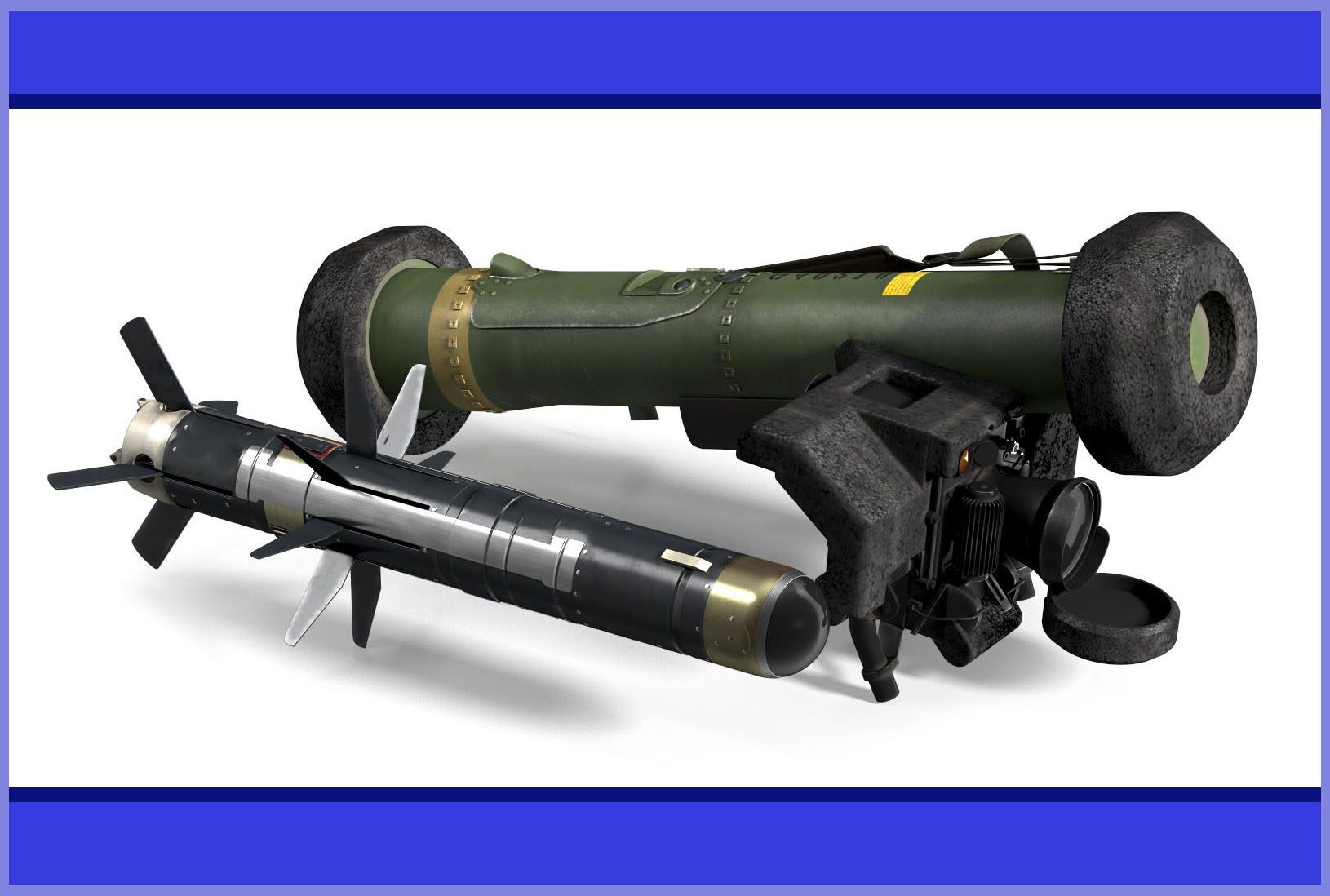Amidst modern warfare advancements, the FGM-148 Javelin, a joint venture between Raytheon and Lockheed Martin, has emerged as a versatile, man-portable, fire-and-forget anti-tank weapon system. The Javelin’s High-Explosive Anti-Tank (HEAT) warhead possesses the capability to defeat modern tanks through a top attack strategy, effectively targeting their weakest point from above. Furthermore, its utility extends to direct assault flights against fortifications. Notably, since the commencement of the war between Ukraine and Russia in 2022, the Javelin has proven to be a nightmare for Russian armoured vehicles.
The Javelin is a close combat/anti-armour weapon system that has been employed in military operations in Afghanistan, Iraq, and the Russian-Ukraine war. Since its introduction in 1996, the Javelin has been utilized by American and coalition forces in over 5,000 encounters. The system is anticipated to remain in the active inventory of the U.S. military through 2050, with orders placed for more than 55,000 Javelin missiles. As a result, the Javelin is continually updated to uphold its superiority against emerging threats and to align with evolving operational requirements.

The initial Javelin test flight occurred in April 1991, followed by the first launcher test firing in March 1993; both tests were successful. The initial deployment of Javelins with US Army troops took place in 1996, following authorization for low production quantities in 1994.
An Overview of the FGM-148 Javelin
It is the world’s most versatile, lethal, man-portable medium-range close combat/anti-armour weapon system. In direct or top attack mode, Javelin strikes armour where it is the most vulnerable. Javelin is optimised for close combat and to defeat armour targets, as well as other vehicles, bunkers, and buildings and it can shoot down flying helicopters as well in close range. Just In similar to Israel Spike – MR/LR.
Proven in the most recent ongoing war between Russia & Ukraine – the Javelin is the weapon of choice for rapid reaction, special operations and light and mechanised infantry forces. Jevelin’s fire-and-forget infrared technology enables infantrymen to engage and destroy the enemy, time after time, under all battlefield conditions. With its low launch signature and close-in-minimum engagement range, gunners can safely engage and destroy the target from within buildings or combat fortifications.
A “soft launch arrangement” involves ejecting the missile from the launcher far enough away from the operator before the primary rocket engines fire. Although this makes it more difficult to locate the launcher, individuals close are still at risk from backblast from the launch tube. As soon as the “fire-and-forget” missile has been launched, the firing crew may move, or they may be ready to fire on their next target right away.
Even though only one soldier may fire the missile system, it is occasionally carried by two soldiers, a gunner and an ammunition carrier. The ammo bearer examines potential targets, keeps an eye out for dangers like enemy vehicles or troops, and makes sure that people and objects are clear of the missile’s launch backblast while the gunner focuses and fires the missile.
Currently operational with the U.S. Marine Corps, the Army, and various international customers, the FGM-148 Javelin has entered into full-rate production. It has received authorization for foreign military sales and has garnered the interest of armed forces from over 20 countries, with 10 allied partners among them.

Decoding the Power of the Javelin Warhead
High-explosive anti-tank (HEAT) tandem warheads are utilized in the Javelin missile. This type of warhead creates a focused stream of superplastically distorted metal. This metal stream is produced by utilizing trumpet-shaped metallic liners combined with an explosive charge that has a specific shape. The outcome of this process is a concentrated and high-speed stream of particles that possess the ability to effectively penetrate armoured surfaces.
The Javelin missile effectively counters explosive reactive armour (ERA) development. Here’s how it works: When a warhead hits, the ERA boxes or tiles placed on a vehicle’s main armour explode. This explosion doesn’t affect the vehicle’s main armour, but it does launch steel panels across the narrow particle stream that the HEAT round produces. This action stops the particle stream from getting through the main armour. The Javelin missile uses two shaped-charge warheads for this purpose. The smaller, weaker HEAT precursor charge destroys the ERA, clearing the path for the larger, stronger HEAT warhead to penetrate the main armour of the target.

A New Development _ Despite the tandem HEAT warhead of the Javelin’s effectiveness in destroying tanks, the majority of threats it was used against in Iraq and Afghanistan were weapon crews and teams, structures, and lightweight and unarmored vehicles. A multi-purpose warhead for the FGM-148F was created by the Aviation and Missile Research, Development, and Engineering Center to increase the use of the Javelin in certain scenarios. The F-Model adds a fragmenting steel case to take out soft targets and light armoured vehicles.
Although it remains highly effective against tanks, the recently developed warhead features a naturally fragmenting steel casing. This casing enhances its personnel-targeting capabilities by creating more fragments upon detonation. Essentially, it merges various elements like blast fragmentation and high-explosive anti-tank properties into a single warhead. The Javelin F-model was scheduled for production commencement in May 2020. The delivery timeline for the upgraded missile design, alongside the introduction of new and lighter Command Launch Units (CLUs) and improved target trackers, was anticipated to initiate in early 2020.

Advanced Propulsion Mechanism of the Javelin Missile
In order to prevent injuries caused by backblasts, most rocket launchers require a significant open area behind the operator. To address this issue without increasing recoil to an unmanageable extent, the Javelin system incorporates a soft launch mechanism. This approach involves using a small launch motor to propel the missile from the launcher, but the motor is designed to extinguish before the missile exits the tube. Following a brief pause that allows the operator to provide the green light, the flight motor is then ignited.
The Javelin missile has a pressure release device to save the launcher from blowing up in the event that the launch motor fails and the launch tube becomes overpressurized, as might happen, for instance, if the rocket becomes stuck. The launch motor is secured in place by a set of shear pins, but these pins can break if the pressure inside the tube builds up too much, allowing the motor to protrude out the back of the tube.
Advanced Seeker Mechanism of the Javelin Missile
For a missile to qualify as a fire-and-forget projectile, it needs to possess the capability to autonomously track and eliminate its designated target post-launch. This self-guidance ability is achieved through the integration of a tracking and imaging system, which is mounted on the seeker.
Once the target has been located and identified, the gunner relies on the missile’s autonomous Infrared (IR) system. This involves setting a track box around the target to establish tracking and achieve a lock. To lock onto the target’s image, the gunner adds brackets around it. The seeker maintains its focus on the target’s image, continuously tracking it as the target changes position, the missile’s flight path adjusts, or attack angles vary.

Advanced Stabilization of the Javelin Missile
To ensure consistent target alignment, it’s crucial to adjust the seeker’s position while simultaneously stabilizing the platform on which it is mounted in accordance with the missile’s movement. This stabilization mechanism should be designed to effectively handle abrupt accelerations, upward/downward shifts, and lateral movements. The adjustment of the platform’s position is accomplished through a combination of a gimbal system, accelerometers, spinning-mass gyros, and motors.
The system operates as a fundamental autopilot. It utilizes guidance electronics that leverage data from the gyros to drive a torque motor connected to the seeker platform. This arrangement ensures that the seeker remains aligned with the target. Careful engineering of the cables connecting the seeker to the rest of the missile is necessary to avoid inducing any unwanted motion or drag on the seeker platform.
Specifications of the FGM-148 Javelin
- Weight: 11.8 kg ( 26.1 lb )
- Length: 42.6 in ( 1,081 mm )
- Diameter: 5.0 in ( 127 mm )
- Warhead: Tandem-Shaped Charged ( HEAT )
- Detonation: Impact
- Propulsion: 2-stage solid propellant
- Effective Range: Basic CLU: from 500 meters to a maximum of 2,500 meters, Lightweight CLU: 4,000 meters & From any Vehicle: 4,750 meters
- Sights: Optical sight & Thermal Imaging
- Speed: Subsonic
- Guidance: Infrared homing / Lock-on before launch, automatic self-guiding
- Seeker: Passive target acquisition/fire control, with integrated day/thermal sight
- Launch Platform: Man-portable launcher
- Shelf life: 10 years
- Ready to fire: < 30 sec
- Reload time: < 20 sec
Moreover, don’t miss out on this exclusive chance to obtain the exquisite large-scale 1/72 premium die-cast models of the formidable F-117A Nighthawk “Toxic Death.” These remarkable and iconic stealth jets, highly acclaimed for their impeccable track record, are currently accessible for purchase on AirModels with worldwide delivery options. Click here now to secure your piece before the limited stock is exhausted.

In conclusion, the FGM-148 Javelin stands as a pinnacle of modern anti-tank warfare technology, with its design embodying both ingenuity and adaptability. With its seeker integrating infrared imaging, the Javelin surpasses weather and environmental barriers, ensuring precise target engagement in all conditions. Its fire-and-forget capability grants operators a tactical edge, allowing them to swiftly shift focus once launched, while its countermeasure resistance bolsters its reliability on the battlefield.
The Javelin’s portability, from the handheld Command Launch Unit to its disposable launch tube, grants flexibility to infantry forces, vehicles, and aircraft alike. Enhanced lethality is achieved through a tandem warhead design, permitting successful armour penetration against formidable targets. The Javelin’s significance in modern combat extends beyond its physical prowess; it symbolizes the continuous evolution of military technology to meet the demands of a complex and ever-changing battlefield.
Important Announcement for Our Valued Readers!
After an article is published, it is possible that updates or changes may have occurred beyond the time of publication. Therefore, it is important to be aware that certain information in the article might be outdated. To ensure the most accurate analysis, it is highly recommended to verify the content with the latest sources available.
However, we are dedicated to delivering outstanding articles on military products and global updates. Maintaining quality and smooth operation requires resources. Your support sustains our efforts in providing insightful content. By purchasing high-quality products through our affiliated links, you help us keep our platform alive and acquire top-notch items. Your unwavering support is invaluable and inspires us to strive further.
We welcome your suggestions and requests for more information, as we value feedback from our readers. If there’s specific defence material or equipment not covered on our site, please share your request in the comments. We’ll strive to research and provide the required information. We sincerely thank you for your unwavering interest in our website, and we eagerly anticipate hearing from you! Enjoy your reading experience!
